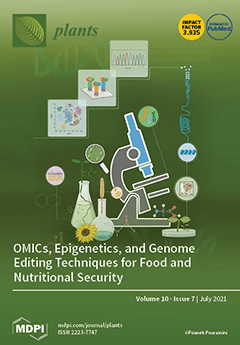Leaf rust, caused by
Puccinia triticina (
Ptr), is a significant disease of spring wheat spread in Kazakhstan. The development of resistant cultivars importantly requires the effective use of leaf rust resistance genes. This study aims to: (i) determine variation in
Ptr population using races from the East Kazakhstan, Akmola, and Almaty regions of Kazakhstan; (ii) examine resistance during seedling and adult plant stages; and (iii) identify the sources of
Lr resistance genes among the spring wheat collection using molecular markers. Analysis of a mixed population of
Ptr identified 25 distinct pathotypes. Analysis of these pathotypes using 16 Thatcher lines that are near-isogenic for leaf rust resistance genes (
Lr) showed different virulence patterns, ranging from least virulent “CJF/B” and “JCL/G” to highly virulent “TKT/Q”. Most of the pathotypes were avirulent to
Lr9,
Lr19,
Lr24, and
Lr25 and virulent to
Lr1,
Lr2a,
Lr3ka,
Lr11, and
Lr30. The
Ptr population in Kazakhstan is diverse, as indicated by the range of virulence observed in five different races analyzed in this study. The number of genotypes showed high levels of seedling resistance to each of the five
Ptr races, thus confirming genotypic diversity. Two genotypes, Stepnaya 62 and Omskaya 37, were highly resistant to almost all five tested
Ptr pathotypes. Stepnaya 62, Omskaya 37, Avangard, Kazakhstanskaya rannespelaya, and Kazakhstanskaya 25 were identified as the most stable genotypes for seedling resistance. However, most of the varieties from Kazakhstan were susceptible in the seedling stage. Molecular screening of these genotypes showed contrasting differences in the genes frequencies. Among the 30 entries, 22 carried leaf rust resistance gene
Lr1, and two had
Lr9 and
Lr68. Lr10 and
Lr28 were found in three and four cultivars, respectively.
Lr19 was detected in Omskaya 37. Two single cultivars separately carried
Lr26 and
Lr34, while
Lr37 was not detected in any genotypes within this study. Field evaluation demonstrated that the most frequent
Lr1 gene is ineffective. Kazakhstanskaya 19 and Omskaya 37 had the highest number of resistance genes: three and four
Lr genes, respectively. Two gene combinations (
Lr1,
Lr68) were detected in Erythrospermum 35 and Astana. The result obtained may assist breeders in incorporating effective
Lr genes into new cultivars and developing cultivars resistant to leaf rust.
Full article






